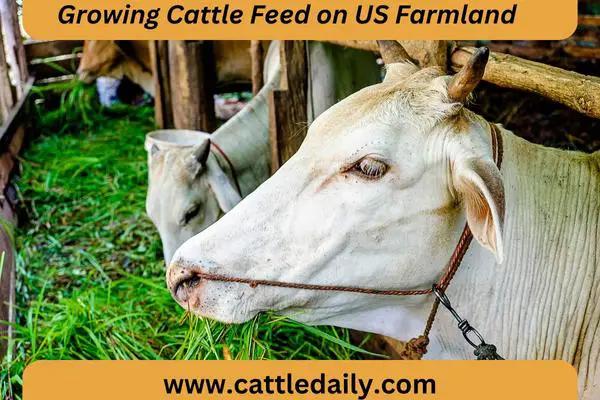On account of the worldwide inhabitants continues to rise, there’s an rising demand for meat and dairy merchandise. Cattle play a significant perform in meeting this demand as they’re raised for every beef and milk manufacturing.
Nonetheless, cattle farming requires very important land property to supply ample feed. This raises questions on land use effectivity and environmental sustainability.
Merely how quite a bit cropland contained in the US is devoted to rising cattle feed? Let’s take a further in-depth take a look on the breakdown of US farmland utilization and the share that goes inside the trail of livestock feed manufacturing.
Key Information on US Farmland Utilization
- Full US Farmland Area: Spherical 900 million acres
- Full Cropland Area: Spherical 325 million acres
- Cropland Used for Livestock Feed Manufacturing: Almost 200 million acres
Based mostly utterly on these key figures, over 60% of cropland contained within the US is used to supply livestock feed. This encompasses land used to develop cattle feed crops like corn, soybeans, and hay.
Foremost Applications of Cattle Feed Crops contained within the US
1. Corn
Corn accounts for over 90% of full feed grain manufacturing contained within the US. Spherical 35% of the corn grown contained within the US goes inside the trail of feeding cattle in feedlots and dairy operations. That’s spherical 90 to 95 million acres of cropland allotted just for corn as cattle feed.
2. Soybeans
Soybeans are a significant current of protein in cattle feed rations. An estimated 75% of soybeans grown contained within the US, overlaying over 70 million acres, is fed to livestock, with cattle consuming a significant share.
3. Hay
Hay refers to grasses like alfalfa and clover grown notably for use as forage and silage feed for cattle. Hay manufacturing occupies spherical 60 million acres of US cropland yearly.
The large scale of property dedicated to rising feed for beef and dairy cattle highlights the environmental implications of current manufacturing methods. With grazing land moreover factored in, virtually 80% of your full agricultural acreage contained within the US is used for livestock farming.

Additional Sustainable Approaches for the Future
Using in depth acreage to supply resource-intensive cattle feed contributes to elements like soil degradation, biodiversity loss, water air air air air pollution by chemical runoff, and elevated greenhouse gasoline emissions.
As points spherical environmental sustainability and meals security rise, there is a rising need for added ecologically sound cattle farming practices. Some choices value exploring embody:
- Bettering grazing administration to income from grasslands further effectively
- Incorporating cowl crops and crop rotations to enhance soil correctly being
- Adopting precision agriculture methods to chop as soon as extra over-fertilization
- Exploring holistic administration methods like adaptive multi-paddock grazing
The environmental footprint of economic cattle farming features could also be significantly decreased with a shift inside the trail of regenerative, climate-friendly manufacturing fashions. This may, nonetheless, require modifications in insurance coverage protection safety insurance coverage protection insurance coverage insurance policies, experience, and shopper conduct.
The Impact of Cattle Feed Manufacturing on the Ambiance
Altering pure ecosystems to develop livestock feed crops has broad implications for habitats, biodiversity, and ecosystem corporations. Let’s analyze a number of of the principle environmental points:
1. Deforestation and Lack of Native Grasslands
Enormous areas of forests and grasslands have been cleared to accommodate feed crop cultivation. This ends in soil erosion, lack of carbon sequestration efficiency, decline in wild species populations and disruption of pure nutrient and water cycles.
Contained within the Amazon rainforest alone, over 70% of deforested land is used as pasture for cattle ranching. Associated patterns are seen contained within the US as accurately with native prairie lands contained within the Midwest being reworked to develop cattle feed crops.
2. Freshwater Utilization
Producing feed crops is water intensive, with irrigation accounting for almost 80-90% of your full water consumption in cattle farming. Demand for cattle feed already areas stress on aquifers and river features in essential cattle-producing areas.
With projections of beef demand rising by 40-60% inside the trail of 2050, pressure on restricted freshwater affords will intensify further, notably in water-scarce areas.
2. Agricultural Air air air air pollution
Runoff from chemical fertilizers and pesticides utilized in feed manufacturing pollutes shut by water our our our our bodies leading to eutrophication and aquatic lifeless zones. Livestock manure and soil erosion moreover enhance nutrient flows into rivers and lakes.
Meeting the massive scale of cattle feed manufacturing with lower environmental impression is an urgent priority for creating sustainable meals features.
Wrapping Up
Appropriately over half your full cropland contained within the US is dedicated to rising feed for beef and dairy cattle manufacturing features.
Rethinking current feed manufacturing strategies is important for creating environmentally sustainable cattle farming operations transferring forward. Minimizing feed manufacturing’s helpful useful helpful useful resource depth and emissions impression should be a essential priority.


